Friday, 11 November 2011
Big Spatial & Open Source week in Canberra, Australia
Tue-Thu 15-17 Nov: Spatial@Gov Conference:
Tuesday at Spatial@Gov is an Open Day to meet vendors. You can register for free at: http://www.cebit.com.au/2011/conferences/spatial-at-gov/registration. Wednesday/Thursday will be for presentations. Two presentations highlight LISAsoft's work - DSE's PLM geospatial data processing chain using Open Source tools is being presented, along with a Gazetteer presentation from Australian National Data Service (ANDS) which highlights a LISAsoft gazetteer client. LISAsoft has a booth at Spatial@Gov and James, Jody, Juliet and myself will all be there. Make sure you see us. (I'm arriving Wednesday morning). If you haven't got a ticket, then give me a call and I'll meet you outside.
7:45am Thu 17 Nov: OSGeo Breakfast:
We are having an informal gathering over breakfast where you can meet others of us interested in Open Source Geospatial Software. We will have demos of software available to look at. Register here: http://www.meetup.com/osgeo-aust-nz/events/40778042/
Mon-Fri 14-18 Nov: Open Source Developers Conference:
OSDC is two days of mini-conferences followed by three days of presentations on Open Source Software. LISAsoft's Jody Garnett is leading a developer workshop on GeoTools, the leading java based open source spatial library used by most java based open source spatial applications, as well as by many proprietary applications too. Introduce yourself to Jody if you see him floating around.
Mon/Tue 14/15 Nov: GeoNetwork Users Workshop:
This workshop will hear brief presentations from many of the Australian agencies who have deployed GeoNetwork, the leading open source metadata storage and publishing system.
The University of Woolongong's SMART Metadata Management and Discovery System, which is being developed by LISAsoft, is being presented. The system is based upon GeoNetwork, GeoServer, Bonita for workflow and a Postgres database. Look out for James Sewell who is one of our developer/architects on this project and who will be attending on Tuesday.
Wednesday, 2 November 2011
Call for interest in OSGeo-Live 5.5
Which project version?
Could each installed project please update our status sheet to note the expected version to be installed on OSGeo-Live 5.5. Status sheet.
Key Priorities for next release
Disk Space
We have reached our DVD size limits, and need to be creative about saving space
Package Updates
Update and test latest stable software releases
Quickstart Reviews
We have Project Quickstarts, but most haven't gone through comprehensive review
Testing
With Quality being a key focus area for us, we need lots of help with testing.
Key Milestones
07 Jan 2012 Feature Freeze
04 Feb 2012 User Acceptance Test (all Apps installed and working)
25 Feb 2012 Final ISO sent to printers
... full schedule
About OSGeo-Live
OSGeo-live is an XUbuntu based distribution of Geospatial Open Source Software, available via a Live DVD, Virtual Machine and USB. You can use OSGeo-Live to try a wide variety of open source geospatial software without installing anything.
Saturday, 1 October 2011
22 Essential Tools for Testing Your Website’s Usability
1. User Task Analysis
- Learnability:
- Intuitiveness:
- Efficiency:
- Preciseness:
- Fault Tolerance:
- Memorability:
- Affordance:
- Ease of Comprehension:
- Legibility:
- Information Architecture (IA):
- Findability:
- Efficiency of Navigation:
- Cross-Browser/Cross-Platform Compatibility:
- Color Choice:
- Use of HTML Accessibility Features:
- Webpage Response Time:
- Webpage Size:
- Code Quality:
- Fulfillment:
- Usefulness:
- Enjoyment:
- Positive Emotions:
Thursday, 22 September 2011
5:1 ROI for Government by leveraging Open Source Communities
The Challenge
OSDM wanted documentation for Open Source Geospatial applications to support their goals of promoting the use of geospatial resources.The Solution
OSDM engaged LISAsoft to lead collaborative documentation development within the OSGeo-Live project. LISAsoft, who are key contributors to OSGeo-Live, supported volunteers from 42 projects to write consistent Project Overviews and Quickstarts. LISAsoft provided vision and leadership, wrote writing templates and guidelines, supported developers, and then provided editorial review.Projects provided their domain expertise and gained quality, consistent documentation, reviewed by professional writers, which is promoted through OSGeo-Live’s marketing channels.
By collaborating with the community, OSDM achieved a 5:1 direct Return on Investment instead of writing all the documentation themselves.
On top of this ROI for documentation, OSDM also gained preconfigured software ready to run, and the community are translating documentation into multiple languages. This results in an indirect ROI of around 20:1.
The take-home
Strategic collaboration with Open Source communities can significantly amplify the impact of government spending.Wednesday, 14 September 2011
LISAsoft is hiring Developers, Project Manager & Sales Person
- Lots of Open Source
- Lots of GeoSpatial Maps
- Lots of Cutting Edge Technology
We are looking for a range of roles, from junior to senior developers, a project manager, and a "technically savvy" sales or pre-sales person. Job descriptions are available here:
- Project Manager: http://www.seek.com.au/Job/project-manager/in/sydney-cbd-inner-west-eastern-suburbs/20620506 (Sydney, Australia)
- Junior Developer: http://www.seek.com.au/Job/junior-software-developer/in/sydney-cbd-inner-west-eastern-suburbs/20666353 (Sydney, Australia)
- Senior Developer: http://www.seek.com.au/Job/java-web-application-developer/in/sydney-cbd-inner-west-eastern-suburbs/20666427 (Sydney or Melbourne, Australia)
- Technically Savvy Sales: Contact me if interested
Wednesday, 7 September 2011
OSGeo-Live 5.0 released - the Open Source Geospatial DVD
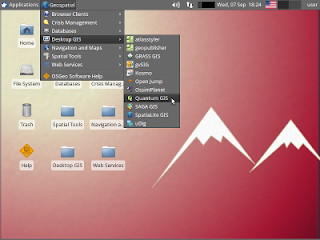 |
| OSGeo-Live Desktop |
OSGeo-Live is a self-contained bootable DVD, USB flash drive and Virtual Machine based upon Ubuntu Linux that is pre-configured with a wide variety of robust open source geospatial software.
The applications can be trialled without installing anything on your computer, simply by booting the computer from the DVD or USB drive.
A DVD or USB of OSGeo-Live is being distributed to every delegate at the upcoming international conference for Free and Open Source Software, http://2011.foss4g.org.
- Homepage: http://live.osgeo.org
Highlights
- 47 Quality GeoSpatial Open Source applications installed and pre-configured
- Quality free world maps
- One page overviews and quick starts for all applications
- Overviews of key OGC standards
- Translations for Greek, German, Polish, Spanish and Japanese
Contents
Browser Clients- OpenLayers 2.10 - Browser GIS Client
- Geomajas - 1.8 Browser GIS Client
- Mapbender 2.7.2 - Geoportal Framework
- MapFish 2.2 - Web Mapping Framework
- GeoMoose 2.4 - Web GIS Portal
- Sahana Eden 0.5.5 - Disaster management
- Ushahidi 2.1 - Mapping and Timeline for events
- PostGIS 1.5 - Spatial Database
- SpatiaLite 2.3.1 / 2.4 beta - Lightweight Database
- Rasdaman 8.2 - Multi-Dimensional Raster Database
- pgRouting 1.05 - Routing for PostGIS
- Quantum GIS (QGIS) 1.7.0
- GRASS GIS 6.4.1
- gvSIG Desktop 1.11
- User-friendly Desktop Internet GIS (uDig) 1.2.2
- Kosmo Desktop 2.0.1
- OpenJUMP GIS 1.4.0.1
- SAGA 2.0.7
- OSSIM 1.8.6 - Image Processing
- Geopublisher 1.7 - Catalogue
- AtlasStyler 1.7 - Style Editor
- osgEarth 2.0 - 3D Terrain Rendering
- GpsDrive 2.11 - GPS Navigation
- Marble 1.0.2 - Spinning Globe
- OpenCPN 2.5.0 - Marine GPS Chartplotter
- OpenStreetMap Tools - JOSM, Merkaartor, Gosmore, Osmarender
- Prune 12 - View, Edit and Convert GPS Tracks
- Viking 9.9.94 - GPS Data Analysis and Viewer
- zyGrib 5.0 - Weather Forecast Maps
- GeoKettle 2.0-RC1 - ETL (Extract, Transform and Load) Tool
- GDAL/OGR 1.8.0 - GeoSpatial Data Translation Tools
- GMT 4.5.2 - Cartographic Rendering
- Mapnik 0.7.1 - Cartographic Rendering
- MapTiler 1.0beta2 - Create Map Tiles
- OTB 3.10 - Image Processing
- R Spatial Task View 2.12.1 - Statistical Programming
- GeoServer 2.1.1
- MapServer 6.0.1
- deegree 3.0
- GeoNetwork 2.6.4 - Metadata Catalog and Catalog Services for Web
- MapProxy 1.1.1 - Proxy WMS & tile services
- QGIS Server 1.7.0 - Web Map Service
- 52°North WSS 2.2.0 - Web Security Service
- 52°North WPS - 2.0 RC6 - Web Processing Service
- 52°North SOS - 3.2.0 Sensor Observation Service
- TinyOWS 1.0 - WFS-T Service
- ZOO Project 1.0.0 - Web Processing Service
- Natural Earth 1.3.1 - Geographic Data Sets
- OSGeo's North Carolina, USA Educational dataset
- OpenStreetMap - Sample extract from OpenStreetMap
- GeoTools - Java GIS Toolkit
- MetaCRS - Coordinate Reference System Transformations
- libLAS - LiDAR Data Access
Credits
Over 80 people have directly helped with OSGeo-Live packaging, documenting and translating, and thousands have been involved in building the packaged software.Packagers, documenters and translators include: Activity Workshop, Agustín Díez, Aikaterini Kapsampeli, Alan Boudreault, Alexandre Dube, Alex Mandel, Andrea Antonello, Andrea Yanza, Angelos Tzotsos, Anne Ghisla, Anton Patrushev, Argyros Argyridis, Astrid Emde, Brian Hamlin, Bruno Binet, Cameron Shorter, Christos Iossifidis, Dane Springmeyer, Daniel Kastl, David Terrativa, Diego González, Dominik Helle, Eike Hinderk Jürrens, Eric Lemoine, Etienne Dube, Fran Boon, François Prunayre, Frank Gasdorf, Gavin Treadgold, Gérald Fenoy, Hamish Bowman, Haruyuki Seki, Henry Addo, Hernan Olivera, Howard Butler, Ian Turton, Jackie Ng, Jan Drewnak, Javier Sanchez, Jesús Gómez, Jim Klassen, Jody Garnett, Johan Van de Wauw, Jorge Sanz, José Antonio Canalejo, Judit Mays, Klokan Petr Pridal, Kristof Lange, Lance McKee, Lars Lingner, Lucía Sanjaime, Mage Whopper, Manuel Grizonnet, Marco Puppin, Mark Leslie, Massimo Di Stefano, Mauricio Miranda, Mauricio Pazos, Michael Owonibi, Mike Adair, Milena Nowotarska, Nathaniel V. Kelso, Ned Horning, Nobusuke Iwasaki, Oliver Tonnhofer, Òscar Fonts, Otto Dassau, Pedro-Juan Ferrer, Pirmin Kalberer, Ricardo Pinho, Ruth Schoenbuchner, Samuel Mesa, Sergio Baños, Simon Cropper, Simon Pigot, Stefan A. Tzeggai, Stefan Hansen, Steve Lime, Thierry Badard, Thomas Baschetti, Trevor Wekel, Valenty Gonzalez, and Yoichi Kayama.
Sponsoring organisations:
- LISAsoft provides sustaining resources and staff toward the management and packaging of software onto the Live DVD. http://www.lisasoft.com
- Information Center for the Environment at the University of California, Davis provides hardware resources and development support to the OSGeo Live project. http://ice.ucdavis.edu
- The DebianGIS and UbuntuGIS teams provide and quality-assure many of the core packages. http://wiki.debian.org/DebianGis and https://wiki.ubuntu.com/UbuntuGIS
Friday, 2 September 2011
Launch of Australian Open Technology Foundation
The Open Technology Foundation (OTF) is an authoritative peak body for the Australian and New Zealand public sector focused on advancing the uptake of open technologies in Government.My understanding of the goals of the OTF is that they wish to provide support services to government agencies in deploying open source and standards based systems.
Tuesday, 9 August 2011
US Defence purchasing emphasises Open Technology Development
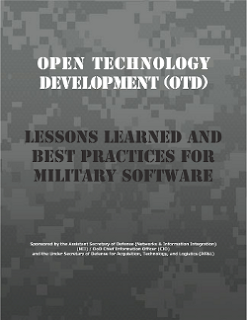
The United States secretary of Defence has released the guide, Lessons Learned & Best Practices for Military Software. It provides some of the most practical software purchasing guidelines for governments to date, and strongly emphasises the use of Open Standards, Open Source, and associated development practices.
Below are some highlights from the paper:
Definition of Open Technology Development:
OTD is an approach to software/system development in which developers collaboratively develop and maintain software or a system in a decentralized fashion. OTD depends on open standards and interfaces, open source software and designs, collaborative and distributed online tools, and technological agility.Key Benefits:
- Increased Agility/Flexibility: Because the government has unrestricted access and rights to the source code developed with taxpayer funds, ...
- Faster delivery: Because developers only need to focus on changes to, existing software capabilities instead of having to redevelop entire systems, ...
- Increased Innovation:...
- Reduced Risk: creating new capabilities from scratch is riskier than re-using existing capabilities...
- Information Assurance & Security: ...
- Lower cost: The first cost to fall by the wayside with OTD is the monopoly rent the government pays to contractors ...
As Defense Secretary Robert Gates has said “The gusher [of money] has been turned off and will stay off for a good period of time.” DoD needs a more efficient software development ecosystem – more innovation at lower cost. OTD squeezes financial waste out of the equation by reducing lock-in and increasing competition.Innovation is fleeting:
... sole possession of the software gives the U.S. a distinct advantage over its adversaries. However, technological advantage is usually fleeting. Often there is a commercially-developed item available to the public that begins to perform similar functions. As it matures, other organizations begin using this non-GOTS solution, potentially rendering the GOTS solution obsolete. Such cases often impose difficult decisions, as the government must determine if it will pay the heavy asymmetrical cost to switch, or if it will continue “as usual” with its now-obsolete GOTS systems.Sample questions provided for:
- Analysis of Alternatives (AoA) ...
- Request for Information (RFI) ...
- Request for Proposal (RFP) ...
- Community first, technology second. Often the military will focus on creating technology solutions when stakeholders aren't onboard or are non-existent. ...
- Default to open, closed only when required.
- Your program is not special. ... Search for existing IT projects and industries and use their solutions.
- Set simple rules about how to share and how to access GOTS. ...
- Intellectual rights. Using open source software licenses greatly simplify rights management for the government.
- Negotiate and demand unlimited rights in software and source code. Government purpose rights are basically crippled license scheme that should be avoided.
- Do not create new software licenses, use existing licenses – they are understood in commercial industry and have been approved by corporate counsels.
- Greatly limit co-mingling of government-funded software with privately-funded software (especially if it is patented). If co-mingling is required develop in a modular fashion and require unlimited rights.
- [Don't] co-mingle export-controlled and classified software with other software. Developers should instead devise a “plug-in” architecture (where possible) that allows use and sharing of software not restricted by export controls or classification.
- Limit incorporating proprietary (especially non-OTS) components that incur licensing fees, especially if the system is designed to depend these components.
- Plan and fund management of the project's community and maintenance of source code as an O&M transition element.
- ...
- Use/modify/create open standards, in that order. Verify that the standards used are open; a simple test for openness is to determine if the standard is implemented by open source software.
- Office of Management and Budget (OMB) M-04-16’s Software Acquisition. This memo simply states that the existing federal policies on software acquisition apply equally to both proprietary and open source software. Note that there is no preference for proprietary software over OSS.
- DoD CIO’s Clarifying Guidance Regarding Open Source Software (OSS) of October 2009. This policy memo specifically notes that “There are positive aspects of OSS that should be considered when conducting market research on software for DoD use”. It even states conditions under which “Software items, including code fixes and enhancements, developed for the Government should be released to the public (such as under an open source license)”.
When picking an OSS license, keep the following criteria in mind:
1. Use an existing OSS license;
2. Make sure it is actually OSS. certified as OSS by the Open Source Initiative (OSI) and as Free Software by the Free Software Foundation (FSF).
3. Use a GPL-compatible license. Most OSS is released using the GNU General Public License (GPL) version 2 or version 3. This does not mean that all OSS must be released using the GPL, but choosing a license incompatible with the GPL (both versions) is very unwise.
...
6. Use a common OSS license.
Image sourced from Open Technology Development paper.
Monday, 18 July 2011
Project Overviews & Quickstarts for New Zealand's SDI Cookbook

New Zealand's Geospatial Office (NZGO) has been making excellent progress toward developing a national Spatial Data Infrastructure (SDI). A few of weeks back, NZGO released their first version of a Spatial Data Infrastrastructure (SDI) Cookbook, which “has been developed to provide guidance for the early stages of implementing a national SDI”.
Its sections cover:
- Data Stewardship and Custodianship Responsibilities
- Introduction to SDI Standards
- Making Data Accessible: Characteristics of a Provider Node
- Making Data Able to be Found: Characteristics of a Catalogue Node
- Using Data Efficiently: How can my Organisation use a SDI? - Participating in a Spatial Data Infrastructure
I'm excited to think that the resulting SDI Cookbook has the potential to become a very valuable resource not just for New Zealand, but for other countries as well. But what I'm particularly interested to see is where this SDI Cookbook will go from here. How will the Cookbook be updated and maintained as technologies improve? Will community feedback be collected? If so, how will it be applied and resourced? How will NZGO balance broad crowd sourced information verses quality review cycles? Will the Cookbook be extented into other areas, such as training? Will other countries collaborate with New Zealand in extending and maintaining the Cookbook, or will rival Cookbooks be developed? These are some of the questions I've been raising with NZGO, and which I believe will determine whether the SDI Cookbook will become wildly successful, or will just briefly be a useful document for a while in New Zealand.
Friday, 17 June 2011
Memoirs of a Cat Herder - Coordinating OSGeo-Live volunteers
 Presented at the GeoRabble forum.
Presented at the GeoRabble forum.I’m about to share some insights into how to build a successful open source community.
Actually, a bit more than that - also how to tap into, and coordinate the expertise of hundreds of world leading developers, packagers, technical writers, project managers, marketers, translators and educators. And have all these people volunteer their time for free.
Because we have actually done all this - in building the OSGeo-Live project. At its core, OSGeo-Live is a DVD pre-configured with close to 50 geospatial Open Source applications, along with accompanying data and documentation, available in multiple languages. It is used in workshops and is handed out at conferences all around the world. I think I'm safe in claiming that OSGeo-Live has grown into a highly successful project, and that we have a learned a number of key lessons worth sharing.
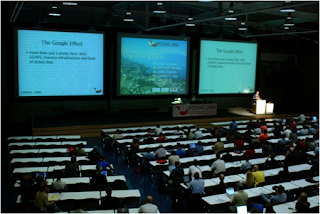 We started OSGeo-Live in 2008 with the aim of building a DVD of geospatial open source which was to be handed out at the international conference for free and open source software for geospatial, or FOSS4G. The FOSS4G conference provides an attractive international marketing pipeline that we could offer projects. And as some of us were on the FOSS4G organising committee we were able to say, "if you get your application installed on OSGeo-Live, then we will hand this DVD out to all attendees at this highly targeted conference".
We started OSGeo-Live in 2008 with the aim of building a DVD of geospatial open source which was to be handed out at the international conference for free and open source software for geospatial, or FOSS4G. The FOSS4G conference provides an attractive international marketing pipeline that we could offer projects. And as some of us were on the FOSS4G organising committee we were able to say, "if you get your application installed on OSGeo-Live, then we will hand this DVD out to all attendees at this highly targeted conference".We laid out a very clear vision of our target deliverable - namely a stable release of Open Source and accompanying marketing documentation. This clear and simple goal helped us many times by providing a framework to test the multitude of decisions that are inevitably encountered in such a project.The process of building our first version of OSGeo-Live involved installing geospatial applications on a base Ubuntu distribution. We followed install instructions, configured applications, resolved dependencies and conflicts, asked questions on email lists, and finally, after much hard work, we produced our first release for the 2008 FOSS4G conference. This was a very important first step as it showed that we had the commitment to follow through and deliver.
 However, it also highlighted a number of our failings. We had followed a fully manual install process, so when the next Ubuntu release came out, we had to start the installation process again, from scratch. This was completely unsustainable. We needed to automate the install process, and we needed projects to show us how.
However, it also highlighted a number of our failings. We had followed a fully manual install process, so when the next Ubuntu release came out, we had to start the installation process again, from scratch. This was completely unsustainable. We needed to automate the install process, and we needed projects to show us how.But our first calls for help from projects was embarrassingly underwhelming. You see, the perceived learning curve for a developer to learn the intricacies of packaging was considered unacceptably high and volunteers were not stepping up.
To fix this, we got one of our packagers to write an example install script along with clear, step-by-step instructions. We then went back to developers with the message of "if you can spend a couple of hours writing a short install script which looks like this, then we will market your application on the OSGeo-Live DVD".
Small effort / High Value. And this worked! 28 projects packaged their applications for our 2.0 release.
We followed the same process with documentation, as our first round of documentation was mostly written by developers and as such was quite ... variable.
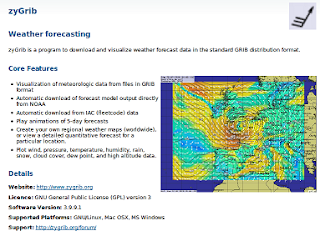 So the Australian Office of Spatial Data Management stepped up and sponsored one of LISAsoft's technical writers to create a template Project Overview, along with writing instructions. We then asked projects to write the documentation, and the technical writer followed up with documentation reviews, then all the documents went through our publishing pipeline in order to produce consistent, quality material. So by applying a template / write / review / publish process, we were able to achieve significant efficiencies by allowing experts to focus only on the bits they do best and thus reduce the cost of contributing.
So the Australian Office of Spatial Data Management stepped up and sponsored one of LISAsoft's technical writers to create a template Project Overview, along with writing instructions. We then asked projects to write the documentation, and the technical writer followed up with documentation reviews, then all the documents went through our publishing pipeline in order to produce consistent, quality material. So by applying a template / write / review / publish process, we were able to achieve significant efficiencies by allowing experts to focus only on the bits they do best and thus reduce the cost of contributing.Another key to our success is that OSGeo-Live doesn't provide free rides for projects. If a project's community doesn't write installers and documentation, then they don't gain the marketing value of OSGeo-Live. This creates the business incentive for projects to help. It also frees up the core OSGeo-Live team to support a multitude of projects.
And by multitude, I mean 50 odd, and 70 odd volunteers, which becomes a project management challenge for a flat organisation structure like ours. To reduce swamping everyone with emails, each project nominates at a contact person to liaise between their project and OSGeo-Live. We use a wiki, issue tracker, email lists, and Google Doc spreadsheets and follow standard project management processes of managing a schedule and tracking status.
The simple statement of "if you want your application on the next release, it needs to be packaged this week" has been a motivating trigger for many of our volunteers to get started.
But the key motivator, along with the fun aspect of working on open source, is that there is a strong business case for each of our contributors to be involved.
- Application developers get valuable marketing, and get their documentation reviewed and translated.
- Our packagers' jobs are a lot easier because domain expects now take ownership of a large part of the packaging task.
- By just sponsoring documentation review, The Australian government's Office of Spatial Data Management gained a 5 to 1 return on investment when creating Project Overviews
- Translators gain quality source documentation and marketing pipeline.
- LISAsoft, who build geospatial systems using Open Source, have increased public acceptance of Open Source, by helping coordinate OSGeo-Live.
- For only the cost of printing, conference and workshop organisers impress delegates by giving them a free, comprehensive DVD of software.
- Likewise, the OSGeo Foundation is gets comprehensive, translated documentation of projects which can be put on its website.
So if I come back to my opening statement of "what is required to tap into, and coordinate the expertise of hundreds of world leading experts, and have them volunteer their time for free?" I guess I'd say:
- Start with a clear and compelling vision; inspiring enough that others want to adopt it and work to make it happen.
- This should be followed by a practical and believable commitment to deliver on the vision. Typically this is demonstrated by delivering a “Minimum Viable Product”.
- Be in need of help, preferably accepting small modular tasks with a low barrier to entry, and ideally something which each person is uniquely qualified to provide. If anyone could fix a widget, then maybe someone else will do it. But if you are one of a few people with the skills to do the fixing, then your gift of fixing is so much more valuable, and there is a stronger moral obligation for you to step up.
- Set a quality bar, and only accept contributions which achieve this level of quality.
- Ensure that every participant gets more out of the project than they put in.
- Avoid giving away free rides. If you are giving away something uniquely valuable; and it costs you time to provide that value for your volunteers; then it is okay to expect something from your volunteers if they wish to get something in return.
- Use templates and processes to facilitate domain experts working together.
- Reduce all barriers that may prevent people from contributing, in particular, by providing step-by-step instructions.
- Set a schedule and work to it.
- Talk with your community regularly, and promptly answer queries.
- And most of all, have fun while you are doing it. Because believe you me, it is hugely rewarding to share the team camaraderie involved in building something that is much bigger and better than you could possibly create by yourself.
Wednesday, 1 June 2011
Australian Government defines Policy for Opening Public Sector Information
Australian Government are continuing their Gov 2.0 agenda, by releasing policy defining the Principles on Open Public Sector Information. It focuses on ensuring that "data be freely available, easily discoverable, understandable, machine-readable and reusable".
The principles are:
- Open access to information – a default position
- Engaging the community
- ... consult the community in deciding what information to publish ...
- ... consult the community in deciding what information to publish ...
- Effective information governance
- Robust information asset management
- Discoverable and useable information
- ... published in an open and standards-based format and is machine-readable
- attach high quality metadata ...
- Clear reuse rights
- ... the default licence condition should be the Creative Commons BY open license.
- Appropriate charging for access
- ... agencies to facilitate public access to information at the lowest reasonable cost.
- Transparent enquiry and complaints processes
Policy: http://www.oaic.gov.au/publications/agency_resources/principles_on_psi_short.pdf
Sunday, 24 April 2011
Secrets of Mashup Design
Friday, 1 April 2011
A Guide to Open Source Software for Australian Government Agencies
The Australian government have released a draft of their revised Guide to Open Source Software for Australian Government Agencies. You can add comments on their blog until 15 April 2011. This guide outlines 3 principles:
1. Agencies will be required to insert a statement into any Request for Tender that they will consider open source software equally alongside proprietary software.
2. Australian Government agencies will require suppliers to consider all types of available software (including but not limited to open source software and proprietary software) when responding to agencies' procurement requests.
3. Australian Government agencies will actively participate in open source software communities and contribute back where appropriate.Image source: http://www.mspmentor.net/wp-content/uploads/2008/11/open_source.gif
Monday, 28 March 2011
OSGeo-Live 4.5, the Open Source Geospatial DVD, released
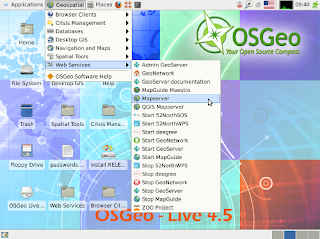 Version 4.5 of the OSGeo-Live GIS software collection has been released. OSGeo-Live is a self-contained bootable DVD, USB flash drive and Virtual Machine based upon Ubuntu Linux that is pre-configured with a wide variety of robust open source geospatial software. The applications can be trialled without installing anything on your computer, simply by booting the computer from the DVD or USB drive.Highlights:
Version 4.5 of the OSGeo-Live GIS software collection has been released. OSGeo-Live is a self-contained bootable DVD, USB flash drive and Virtual Machine based upon Ubuntu Linux that is pre-configured with a wide variety of robust open source geospatial software. The applications can be trialled without installing anything on your computer, simply by booting the computer from the DVD or USB drive.Highlights:- 45 Quality GeoSpatial Open Source applications installed and pre-configured
- Quality free world maps
- One page overviews and quick starts for all applications
- Overviews of key OGC standards
- Translations for Greek, German, Polish, Spanish and Japanese
- 52º North SOS (Sensor Observation Service) 3.1.1
- 52º North WPS (Web Processing Service) 2.0 RC6
- AtlasStyler (Feature Style Editor) 1.6
- deegree (Web Services) 2.3
- GDAL/OGR (GeoSpatial Data Translation Tools) 1.7.3
- GeoKettle (Business Intelligence) 3.2.0-20090609
- Geomajas (Browser GIS Client) 1.8
- GeoNetwork (Metadata Catalog) 2.6.3
- Geopublisher (Electronic Library Manager) 1.6
- GeoServer (Web Service) 2.1rc1
- GMT (Generic Mapping Tools) 4.5.1
- GpsDrive (GPS Navigation Software) 2.11
- GRASS GIS (Fully featured GIS) 6.4.0
- gvSIG Desktop (Desktop GIS) 1.10
- Kosmo Desktop (Desktop GIS) 2.0
- Mapbender (Geoportal Framework) 2.7
- MapFish (Web Mapping Framework) 2.0
- MapGuide Open Source (Web Service) 2.2.0
- Mapnik (Cartographic rendering engine) 0.7.0
- MapServer (Web Service) 5.6.6
- MapTiler (Tiled Map Publishing) 1.0beta2
- Marble (3D desktop globe) 0.9.5
- MB-System (Sea floor mapping) 5.2.1880
- OpenCPN (Marine GPS navigation) 2.3.1
- OpenJUMP GIS (Desktop GIS) 1.4.0.1
- OpenLayers (Browser GIS Client) 2.10
- osgEarth (Terrain rendering toolkit) 2.0
- OpenStreetMap (Tools for mapping the world) 3751
- OSSIM (Image Processing) 1.8.10
- OTB - ORFEO Toolbox Library (Image Processing) 3.8.0
- pgRouting (GIS Tools) 1.05
- PostGIS (Spatial Database) 1.5.2
- Prune (GPS Track Editing) 10-1 Lucid
- Quantum GIS (Desktop GIS) 1.6.0
- QGIS mapserver (Web Service) 1.6.0
- Rasdaman (Multi-Dimensional Raster Database) 8.1
- R Spatial (Statistical Programming) 2.12.1
- SAGA (Desktop GIS) 2.0.5
- Sahana (Disaster management) Eden 0.5.3
- SpatiaLite (Spatial Database) 2.4
- uDig (Desktop GIS) 1.2.0
- Ushahidi (Crowd Sourced Event Mapping) 2.0.1
- Viking (Manage and plot GPS data) 0.9.9
- ZOO Project (Web Processing Service) 1.2.0
- zyGrib (Weather forecasting) 3.9.9.1
Credits:
Over 60 people have directly helped with OSGeo-Live packaging, documenting and translating, and thousands have been involved in building the packaged software.
Packagers and documenters: Alan Boudreault, Alex Mandel, Alexandre Dube, Andrea Antonello, Anton Patrushev, Astrid Emde, Brian Hamlin, Bruno Binet, Cameron Shorter, Dane Springmeyer, Daniel Kastl, Eike Hinderk Jürrens, Eric Lemoine, Etienne Dube, Fran Boon, François Prunayre, Gavin Treadgold, Gérald Fenoy, Hamish Bowman, Haruyuki Seki, Henry Addo, Ian Turton, Jody Garnett, Johan Van de Wauw, Jorge Sanz, Juan Lucas Domínguez Rubio, Judit Mays, Klokan Petr Pridal, Kristof Lange, Lance McKee, Manuel Grizonnet, Mark Leslie, Massimo Di Stefano, Michael Owonibi, Nathaniel V. Kelso, Pirmin Kalberer, Ricardo Pinho, Sergio Baños, Simon Pigot, Stefan A. Tzeggai, Stefan Hansen, Thierry Badard and Trevor Wekel
Translators: Aikaterini Kapsampeli, Angelos Tzotsos, Anne Ghisla, Argyros Argyridis, Astrid Emde, Christos Iossifidis, Daniel Kastl, Haruyuki Seki, Javier Sanchez, Jorge Sanz, Lars Lingner, Marco Puppin, Massimo Di Stefano, Milena Nowotaska, Nobusuke Iwasaki, Otto Dassau, Ruth Schoenbuchner, Thomas Baschetti, Valenty Gonzalez and Yoichi Kayama
Sponsoring institutions:
LISAsoft provides sustaining resources and staff toward the management and packaging of software onto the Live DVD. http://www.lisasoft.com
Information Center for the Environment at the University of California, Davis provides hardware resources and development support to the OSGeo Live project. http://ice.ucdavis.edu
The DebianGIS and UbuntuGIS teams provide and quality-assure many of the core packages.
The Australian Government's Office of Spatial Data Management sponsored reviews of software marketing documentation. http://www.osdm.gov.au
Tuesday, 1 March 2011
Australian Defence embrace interoperablity through standards
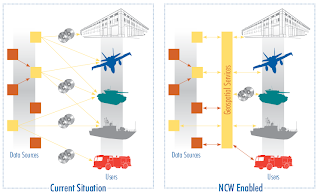
The Australian Defence Geospatial Strategy 2010 outlines how Defence intends to embrace the use of standards within a Service Oriented Architecture (SOA) for delivering geospatial functionality.
The application of Defence geospatial information and technology standards is vital to achieving a geospatially networked force. In order to allow geospatial information to be delivered seamlessly across the network from the strategic to the tactical level the capabilities that Defence acquires in the future must be able to ingest standard data formats. Non-compliance with standards will result in additional costs and delays in the acquisition of systems. Once operational, non-compliant platforms adversely affect interoperability and create an ongoing requirement to convert proprietary data formats into standard data formats resulting in systems that are expensive and unsupportable in the long term. It is important, therefore, that Geospatial Standards, including metadata standards, are collaboratively developed, managed and published across all of Defence.This move toward standards will be particularly valuable for Australia's long term spatial capabilities as defence initiatives will also benefit geospatial services in government and private sectors.
Thursday, 24 February 2011
Australian government embrace "pro-disclosure" of information
I've been hearing rumours that many Australian government departments are investigating how to publish their data online. This is justified by an amendment to Australian's Freedom of Information Act, published June 2010, which describes a pro-disclosure culture relating to information.
The changes are explained on the government website:
The objects of the FOI Act are a clear statement of the intention to promote disclosure of information held by government. The objects include to:
- give the Australian community access to information by requiring agencies to publish the information, and provide a right of access
- contribute to increased participation in government processes and increased scrutiny, discussion and review of government activities
- increase recognition that information held by government is a national resource
- promote public access to information, promptly and at the lowest reasonable cost.
Source: http://www.oaic.gov.au/foi/what.html#pro_disclosure_culture
Saturday, 29 January 2011
Australian government now to actively consider Open Source
Australian Government agencies must actively and fairly consider all types of available software (including but not limited to open source software and proprietary software) through their ICT procurement processes....
The Government’s previous policy, established in 2005, was one of ‘informed neutrality.’ This meant that agencies took an unbiased position that did not favour open source or proprietary software and procured the solution that was the best ’value for money’ and ‘fit for purpose’ for their specific requirement. Since then, there has been an increase in the maturity of the open source software products and the use of open source software by governments around the world. In recent years, many governments have revised their policies to increase the adoption of open source software.
This revised Australian Government policy on open source software will ensure that we maintain international best practice and that our purchases of software will continue to reflect best value for money for the Government.
This is a great first step, however, government purchasing practices will continue to inadvertently favour proprietary software until we see guidelines on how to compare the value Open Source and Proprietary Software which includes tools to assess the holistic value of Open Source. This is explained in the article Governments don’t know how to buy free software. A good starting point would be the European Union Guideline for Public administrations on Procurement and Open Source Software.





